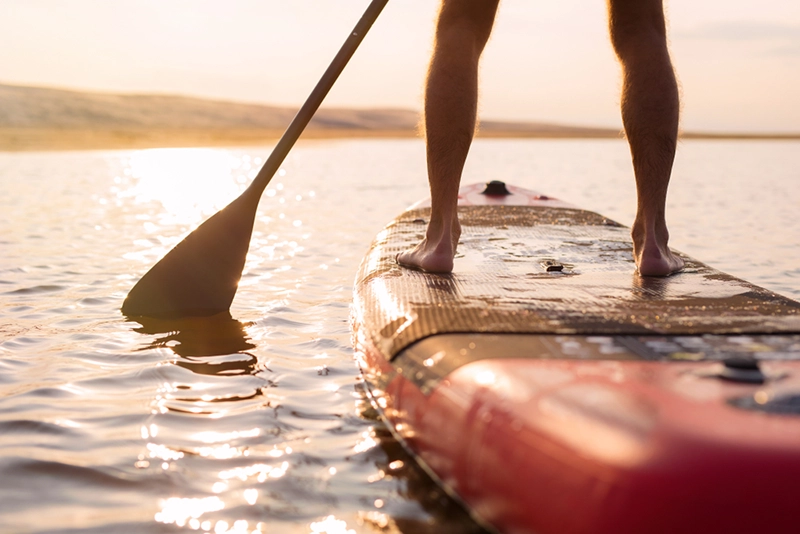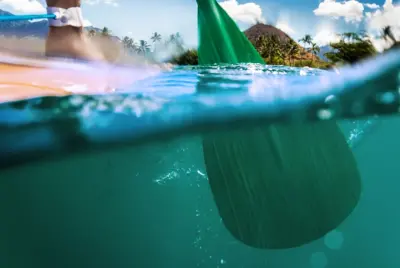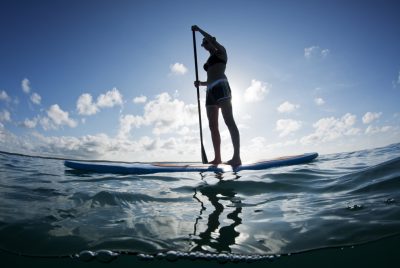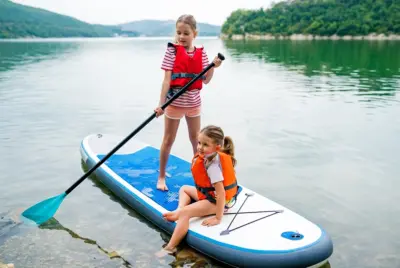Is Paddleboarding Hard? An Enthusiast’s Take
We may earn a commission for purchases made using our links. Please see our disclosure to learn more.
Hello there! As someone who’s passionate about paddle boarding, I often get asked, “Is paddleboarding hard?” Let’s dive into this question together and hopefully, I can share some of my insights and tips with you.
Understanding Paddle Boarding
Before we answer if paddleboarding is hard, it’s essential to understand what it is.
The Basics of Paddle Boarding
Paddle boarding is a water sport where you stand on a board and use a paddle to propel yourself across the water. Sounds simple, right? You’ll need a paddleboard (obviously), a paddle, and, for safety, I’d recommend a leash and a personal flotation device.
The Challenge of Paddle Boarding
So, back to our main question: is paddleboarding hard?
Physical Requirements
Paddle boarding can be physically demanding. It requires core strength, upper body strength for paddling, and lower body strength for balance.
Is Paddleboarding Hard? Exploring the Challenge of Balance and Coordination
Balance is why potential paddle boarders ask the question if paddleboarding is hard? Standing on a board on water isn’t easy. It requires balance and coordination. But don’t worry, with practice, you’ll get the hang of it!
Environmental Factors
The wind, current, and waves can make paddle boarding challenging. But again, with time, you’ll learn how to handle these conditions.
Tips for Beginners
Paddleboarding is hard and can be a bit intimidating at first, but I assure you, with the right guidance and persistence, you’ll be up and running (or should I say, standing and paddling) in no time. Here are some essential tips to help you start:
Getting Started – Start on calm water. It’s easier to balance and control the board and there’s less to distract or destabilize you. Kneel on the board first to get a feel of the balance. When you’re comfortable, stand up one foot at a time while keeping your feet parallel and hip-distance apart.
Safety – Never underestimate the importance of safety. Always wear a personal flotation device and use a leash that tethers your paddleboard to you. This ensures that you don’t lose your board if you fall off.
Mastering the Paddle Boarding Stance – Stand up one foot at a time and keep your feet parallel and hip-distance apart. Keep your toes pointed forward, knees slightly bent, and your back straight. A common mistake beginners make is looking at their feet instead of the horizon. Trust me, keeping your gaze forward will help you maintain balance.
Paddling Techniques – Learn the basic paddling techniques: the forward stroke for moving forward, the reverse stroke for moving backward, and the sweep stroke for turning. Paddling might seem straightforward, but there’s a technique to it. When paddling on the right, your right hand should be lower and your left hand on top, and vice versa. Paddle alongside the board and remember to switch sides regularly.
Learning to Fall – Falling is part of the learning process. Try to fall to the side, so you don’t fall directly onto the board. Remember to hold onto your paddle, and use your leash to retrieve your board if it starts to float away. And then get back up and try again.
“On top of the board I glide, the river’s current my trusted guide, freedom found with every stride.”
Benefits of Paddle Boarding
Still wondering is paddleboarding hard? Paddle boarding isn’t just about the challenge; there are benefits too!
Health and Fitness Rewards
Engaging in paddle boarding provides a wide range of health and fitness rewards. Firstly, it is an excellent full-body workout that targets multiple muscle groups. When paddling, the muscles in your arms, shoulders, back, and core are constantly engaged, helping to strengthen and tone these areas. Additionally, maintaining balance on the board requires the activation of leg muscles, contributing to improved lower body strength and stability.
Paddle boarding is also a low-impact activity, which means it puts less stress on your joints compared to high-impact exercises like running. This makes it a suitable option for individuals of different fitness levels and those who may have joint issues or injuries. The gentle movements of paddle boarding also help improve flexibility and joint mobility.
Furthermore, paddle boarding is a great cardiovascular exercise. It elevates your heart rate, increasing circulation and oxygen flow throughout the body. Regular paddle boarding sessions can improve cardiovascular endurance and overall fitness levels.
Mental Well-being
Engaging in paddle boarding offers numerous benefits for mental well-being. The combination of being out on the water, surrounded by nature, and participating in physical activity has a positive impact on our mental state. Firstly, paddle boarding allows us to disconnect from the stresses of everyday life and immerse ourselves in the present moment. As we glide across the water, the rhythmic motion and the peaceful surroundings promote a sense of calm and relaxation, helping to alleviate anxiety and reduce stress levels.
Additionally, paddle boarding has been shown to have mood-boosting effects. The physical activity releases endorphins, which are natural feel-good hormones that contribute to improved mood and a sense of well-being. The tranquil and serene environment, with the soothing sound of water and the beauty of nature, further enhances our mood and promotes a sense of inner peace.
Moreover, paddle boarding can provide a meditative experience. The repetitive motion of paddling and the gentle swaying of the board can induce a state of mindfulness, where we become fully present and focused on the sensations and surroundings. This mindfulness practice helps to quiet the mind, reduce mental chatter, and increase a sense of clarity and mental clarity.
Connection with Nature
 One of the major benefits of paddle boarding is the profound connection it allows you to establish with nature. Unlike other water sports or activities, paddle boarding offers a unique vantage point where you are literally standing on the water. This close proximity to the natural environment creates an incredible sense of immersion and allows you to experience nature in a whole new way.
One of the major benefits of paddle boarding is the profound connection it allows you to establish with nature. Unlike other water sports or activities, paddle boarding offers a unique vantage point where you are literally standing on the water. This close proximity to the natural environment creates an incredible sense of immersion and allows you to experience nature in a whole new way.
As you paddle across serene lakes, glide along calm rivers, or venture into the ocean, you become attuned to the sights, sounds, and even the gentle movements of the water beneath you. The rhythmic paddling, accompanied by the peaceful surroundings, creates a meditative experience that helps you disconnect from the stresses of daily life and fully embrace the present moment.
Paddle boarding also enables you to explore hidden coves, remote corners, and untouched shorelines that may not be accessible by other means. You can discover stunning landscapes, encounter wildlife in their natural habitats, and witness breathtaking sunrises or sunsets over the water. This intimate connection with nature not only enhances your appreciation for the environment but also fosters a sense of stewardship and a desire to protect these natural spaces for future generations.
Moreover, paddle boarding encourages a slower pace, allowing you to take in the details of the surrounding ecosystem. You may notice the vibrant colors of aquatic plants, observe birds gracefully soaring overhead, or even catch a glimpse of marine life swimming beneath your board. This direct engagement with the natural world sparks curiosity, encourages a deeper understanding of ecological systems, and nurtures a sense of wonder and awe.
The tranquility and serenity of paddle boarding in nature have also been found to have therapeutic effects on mental and emotional well-being. Being surrounded by natural elements can reduce stress levels, increase mindfulness, and promote relaxation. It offers a welcome escape from the noise and distractions of urban life, providing a sanctuary to reconnect with yourself and find solace in the beauty of the great outdoors.
Paddle boarding also provides a unique opportunity to connect with nature. It’s just you, your board, and the water.
Common Paddle Boarding Misconceptions
Many people think that paddle boarding is too hard or that you need to be an excellent swimmer. While swimming skills are beneficial, wearing a personal flotation device can keep you safe. And as for the difficulty – well, like any new sport, there’s a learning curve, but don’t let that deter you!
Turning the Challenge into Fun
Instead of viewing paddle boarding as hard, see it as a fun challenge. Each time you fall, you’re learning. Each time you get back on the board, you’re improving.
Advancing Your Paddle Boarding Skills
Once you’ve got the basics down, there’s so much more to explore in paddle boarding!
Learning New Techniques
Advancing your paddle boarding skills can open up a whole new world of possibilities and enjoyment on the water. Once you have mastered the basics of balance and paddling, there are various techniques and maneuvers you can learn to take your paddle boarding to the next level.
One important aspect to focus on is refining your paddling technique. Efficient paddle strokes can help you increase speed, maneuverability, and overall efficiency on the water. Pay attention to your grip on the paddle, your body positioning, and the angle of your paddle in the water. By practicing and honing your technique, you can paddle with greater ease and precision.
Another skill to develop is turning. Learning how to execute smooth and controlled turns will greatly enhance your paddle boarding experience. There are different turning techniques to explore, such as sweep turns, pivot turns, and back paddling. Each technique has its own advantages and can be applied in various situations, allowing you to navigate different water conditions with confidence.
For those looking for more excitement, wave riding is a skill worth exploring. Riding waves on a paddleboard requires timing, balance, and the ability to read and anticipate wave patterns. It can be an exhilarating experience to catch and ride waves, whether in the ocean or on a river. Wave riding adds a new dimension to paddle boarding, combining skill and adrenaline for an unforgettable adventure.
Additionally, you can challenge yourself by embarking on longer paddling journeys, exploring new waterways, or participating in paddle boarding races and events. Pushing your limits and setting new goals can help you progress and continually improve your skills.
Exploring Different Paddle Boarding Styles
Did you know you can do yoga on a paddleboard? Or what about paddleboard fishing? The possibilities are endless!
Conclusion
So, is paddleboarding hard? It can be challenging at first, but with patience, practice, and a positive mindset, you’ll be paddling like a pro in no time. And trust me, the rewards are well worth the effort!
Frequently Asked Questions (FAQs)
- Do I need to be a good swimmer to paddle board?
Being comfortable in the water is beneficial, but you don’t need to be an expert swimmer. Always wear a personal flotation device for safety. - Is paddle boarding a good workout?
Absolutely! It’s a full-body workout that improves your strength, balance, and endurance. - Can children paddle board?
Yes, with proper supervision and safety equipment, children can enjoy paddle boarding. - How long does it take to learn paddle boarding?
It varies from person to person, but many people can stand and paddle on calm water after their first lesson. - Can I paddle board if I’m not in perfect shape?
Definitely! Paddle boarding can be enjoyed by people of all fitness levels. Start slow and gradually increase your intensity as your strength and balance improve.




